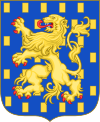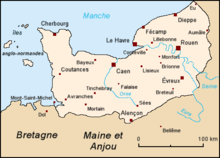User:Timsaunt/Robert, Count of Eu
| This is not a Wikipedia article: It is an individual user's work-in-progress page, and may be incomplete and/or unreliable. For guidance on developing this draft, see Wikipedia:So you made a userspace draft. Find sources: Google (books · news · scholar · free images · WP refs) · FENS · JSTOR · TWL |
Robert, Count of Eu
Robert d'Eu 5th Comte d'Eu Lord of Hastings | |
|---|---|
 Arms of the Comtes d'Eu from the House of Normandy: D'azur, au lion d'or,l'écu semé de billettes d'or | |
| Hereditary | |
| Comte d'Eu | after 1053-c.1091 |
| Predecessor | Guillaume Busac, son of Guillaume I d'Eu |
| Successor | Guillaume II, Lord of Hastings, |
| Born | c.1020 |
| Died | After 1091 |
| Buried | l'Abbaye Saint-Michel du Tréport, Le Treport, Duchy of Normandy |
| Family | de Clare |
| Wife | 1st - Juliana FitzRalf, 2nd - Quornormau de Normandie 3rd - Beatrice de Falaise, 4th - Mathilde de Hauteville (?- repudiated c.1080) |
| Issue | Raoul d'Eu, Guillaume II Comte d'Eu, Lord of Hastings, Condona d'Eu, Comtesse d'Angouleme, Robert d'Eu, Walter Hastings + 2 others |
| Father | Guillaume I, Comte of Eu |
| Mother | Lesceline de Harcourt de Turqueville |
| Occupation | Norman Peerage |

Robert d'Eu, 5th Comte of d'Eu (c. 1020 – after 1091), was the eldest son and successor of Guillaume 3rd Comte d'Eu, illegitimate son of Duke Richard I of Normandy, and Lesceline de Harcourt de Turqueville.
Life[edit]
Robert d'Eu was son of Guillaume, Comte d'Eu who was an illegitimate son of Richard I of Normandy[1]. He succeeded his brother Guillaume Busac as Comte d'Eu, possibly following his brother's revolt against Duke Richard II of Normandy[2]
In 1066 Robert contributed 60 ships to the Norman invasion fleet [3] and hence was a major contributor to the overall total of 696 ships. In around 1070, William the Conqueror gave Robert d'Eu, the rape of Hastings which occupied a fifth of Sussex, after Onfroy du Tilleul, the nephew of Hugh de Grandmesnil, fled to Normandy[4]. The Domesday Book (1086) shows that Robert held 75 manors in Sussex while his son Guillaume held a number spread across the south and west of England. Their revenue from these lands came to some £690 [5]. They were therefore, if not the richest barons, then at least amongst them[5].
In 1069 Robert d'Eu was appointed by the King along with Robert de Mortain to guard against the Danes whose fleet was anchored in the mouth of the Humber, while the revolt initiated by Eadric the Wild in the West Midlands [6]. When the Danes advanced from their fleet to plunder the neighborhood, the two men and their army defeated them and forced them to flee by sea[7] · [8].
After the death of William the Conqueror, Robert d'Eu supported Robert Curthose. But in due course he transferred his allegiance to William Rufus. The Treaty of Caen (February 1091), which attempted to reconcile William II and Robert Curthose, left the County of Eu as a possession of the English King indicating that Robert d'Eu was one of his supporters [9].
Death[edit]
Robert d'Eu died some time after the Treaty of Caen and before 1093, when his son Guillaume was recognized as Comte d'Eu[9]. He is buried in the Abbey of Saint-Michel du Tréport, which he had founded in Le Tréport, near Eu, some time between 1057 and 1066.
Children[edit]
- Raoul d'Eu,
- Guillaume II Comte d'Eu, Lord of Hastings,
- Condona d'Eu, Comtesse d'Angouleme,
- Robert d'Eu,
- Walter Hastings
- 2 others
References[edit]
[1] [3] [4] [5] [6] [7] [8] [9]
- ^ a b Charpillon, Louis-Étienne; Caresme, Anatole (1868). Delcroix (ed.). Dictionnaire historique de toutes les communes du département de l'Eure (in French). Vol. 1. Les Andelys.
{{cite book}}: CS1 maint: location missing publisher (link) - ^ David Crouch, The Normans: The History of a Dynasty, Continuum International Publishing Group, 2006, p.65.
- ^ a b C. Warren Hollister, « The Greater Domesday Tenants-in-Chief », Domesday Studies, Éd. J.C. Holt (Woodbridge), 1987, p. 244.
- ^ a b Eleanor M. Seale, « The Abbey of the Conquerors », Proceedings of the Battle Conference on Anglo-Norman Studies II, 1979: Proceedings of the Battle Conference 1979, Par Reginald Allen Brown, Publié par Boydell & Brewer, 1980, p. 157. ISBN 0851151264
- ^ a b c C. Warren Hollister, « The Greater Domesday Tenants-in-Chief », Domesday Studies, Éd. J.C. Holt (Woodbridge), 1987, p. 226-227.
- ^ a b Frank Stenton, Anglo-Saxon England, Oxford University Press, 3 édition, 1971, p. 604.
- ^ a b Brian Golding, « Robert of Mortain », Anglo-Normans Studies : XIII. Proceedings of the Battle Conference, édité par Marjorie Chibnall, Boydell & Brewer Ltd, 1990, p.120
- ^ a b Orderic Vital, Histoire de Normandie, Éd. Guizot, 1826, tome 2, livre IV, p. 186.
- ^ a b c Frank Barlow, William Rufus, Yale University Press, 2000, pp.273, 282.

